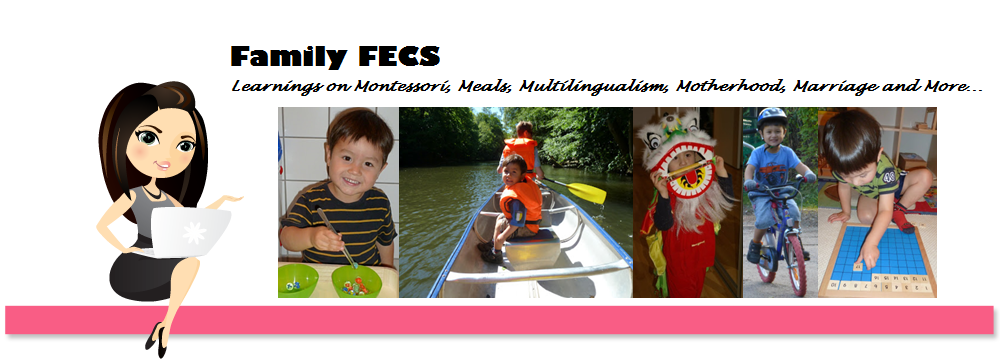Age: From 3 years old
Activity Duration: 5 - 15 minutes
Objective: To inculcate the significance of Chinese New Year and make it come alive for the children living overseas
Materials:
1. 1 Lion Dance Costume (child-friendly size)
2. 1 Chinese drum
3. 1 set of cymbals (optional)
4. 1 basket with mandarin orange, lettuce, banana, etc. for the lion to "eat"
Directions:
1. Hang a basket of "treats" for the lion e.g. mandarin orange, lettuce, banana, etc. in the middle of the room (or if not possible, place it in the middle of the floor).
2. Beat the drum and the cymbals... demonstrate by entering the hungry lion.
3. The lion encircles around the basket of treats and gobble up the mandarin orange (slip it through the hole in the lion puppet's mouth)
4. The lion does some criss-cross footwork, go around in circle again and go for the lettuce.
5. Encourage the children to take turn to try.
Cost:
Lion Dance costume: 28.80 SGD
Drum: 28.80 SGD
Additional Information:
Living overseas in a non-Chinese environment made me think harder about how I can impart the Chinese cultural heritage to Joshua and labouriously hand-carried this lion head and drum across sky, land and sea all the way home from Singapore (of course with Florian's help). Thankfully, I found this great idea from a very creative mother Julia of
Hapa Lab, who did a fantastic job explaining the activity and the Chinese new year celebration. It is an excellent way of providing heritage education of Chinese new year to the children and making the event more memorable.
Prior to the day of Chinese new year celebration itself, we practised the lion dance with Joshua and Amy, but they were not so interested. We started the day with the Chinese reunion lunch (instead of dinner for the benefit of young children). It was then followed by the lion dance programme. However, on the actual day, towards the end of the party, they finally warmed up to it and had a great time playing with it. It was our first time doing this, and it was not very organized. We did not manage to follow the ideal directions that we set out to do, but it didn't matter as the idea of lion dance was conveyed to the children in the end. And Sarah, Joshua and Amy had a lot of fun with it in the end that Joshua did not want to go home.
When the lion head is not in use for the activity, it can be used as decoration for the Chinese new year in the home.
During this festive season, you can find this child-friendly Chinese lion dance decorative costume all over Chinese New Year festive market in Singapore's Chinatown. I bought it in Carrefour in Singapore.
As well-explained by Wikipedia, during the Chinese New Year, lion dancer troupes from the Chinese martial art schools or Chinese guild and associations will visit the houses and shops of the Chinese community to perform the traditional custom of "cai ching" (採青), literally means "plucking the greens", a quest by the 'lion' to pluck the auspicious green normally 'vegetables' like lettuce which in Chinese called 'cái'(菜)that sound like 'cái'(财)(fortune) and auspicious fruit like oranges tied to a "Red Envelope" containing money; either hang highly or just put on a table in front of the premises. The "lion" will dance and approach the "green" and "red evelope" like a curious cat, to "eat the green" and "spit" it out leave it in a nice arrangement, like an auspicious character but keep the "red envelope". The lion dance is believed to bring good luck and fortune to the business and the troupe is rewarded with the "red envelope".
Lion Dance is performed accompanied by the music of beating of drums, cymbals, and gongs instruments synchronise to the lion dance movements and actions. Basic lion dance movement can be found in Chinese martial arts.
The lion dance is also usually performed at many other important grand occasions, including Chinese traditional, cultural and religious festivals, business opening events, birthday celebrations, honour guest welcoming and wedding ceremonies by the Chinese communities.
References:
http://en.wikipedia.org/wiki/Lion_dance

And here is our family wishing all Chinese a happy and prosperous Chinese New Year in the Year of the Dragon


